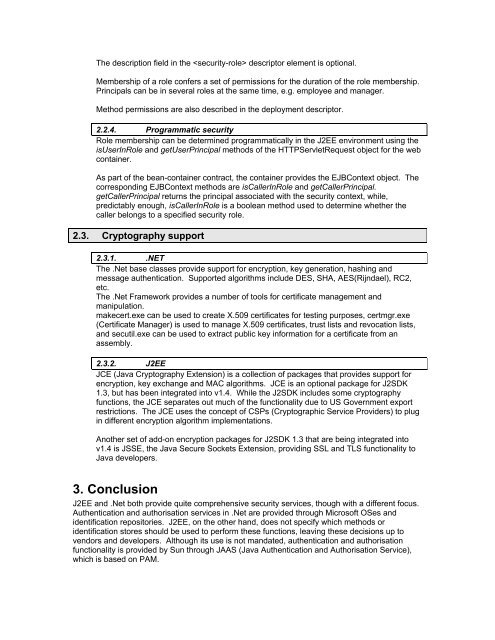J2ee and .Net security, (PDF) - CGISecurity
J2ee and .Net security, (PDF) - CGISecurity
J2ee and .Net security, (PDF) - CGISecurity
Create successful ePaper yourself
Turn your PDF publications into a flip-book with our unique Google optimized e-Paper software.
The description field in the descriptor element is optional.<br />
Membership of a role confers a set of permissions for the duration of the role membership.<br />
Principals can be in several roles at the same time, e.g. employee <strong>and</strong> manager.<br />
Method permissions are also described in the deployment descriptor.<br />
2.2.4. Programmatic <strong>security</strong><br />
Role membership can be determined programmatically in the J2EE environment using the<br />
isUserInRole <strong>and</strong> getUserPrincipal methods of the HTTPServletRequest object for the web<br />
container.<br />
As part of the bean-container contract, the container provides the EJBContext object. The<br />
corresponding EJBContext methods are isCallerInRole <strong>and</strong> getCallerPrincipal.<br />
getCallerPrincipal returns the principal associated with the <strong>security</strong> context, while,<br />
predictably enough, isCallerInRole is a boolean method used to determine whether the<br />
caller belongs to a specified <strong>security</strong> role.<br />
2.3. Cryptography support<br />
2.3.1. .NET<br />
The .<strong>Net</strong> base classes provide support for encryption, key generation, hashing <strong>and</strong><br />
message authentication. Supported algorithms include DES, SHA, AES(Rijndael), RC2,<br />
etc.<br />
The .<strong>Net</strong> Framework provides a number of tools for certificate management <strong>and</strong><br />
manipulation.<br />
makecert.exe can be used to create X.509 certificates for testing purposes, certmgr.exe<br />
(Certificate Manager) is used to manage X.509 certificates, trust lists <strong>and</strong> revocation lists,<br />
<strong>and</strong> secutil.exe can be used to extract public key information for a certificate from an<br />
assembly.<br />
2.3.2. J2EE<br />
JCE (Java Cryptography Extension) is a collection of packages that provides support for<br />
encryption, key exchange <strong>and</strong> MAC algorithms. JCE is an optional package for J2SDK<br />
1.3, but has been integrated into v1.4. While the J2SDK includes some cryptography<br />
functions, the JCE separates out much of the functionality due to US Government export<br />
restrictions. The JCE uses the concept of CSPs (Cryptographic Service Providers) to plug<br />
in different encryption algorithm implementations.<br />
Another set of add-on encryption packages for J2SDK 1.3 that are being integrated into<br />
v1.4 is JSSE, the Java Secure Sockets Extension, providing SSL <strong>and</strong> TLS functionality to<br />
Java developers.<br />
3. Conclusion<br />
J2EE <strong>and</strong> .<strong>Net</strong> both provide quite comprehensive <strong>security</strong> services, though with a different focus.<br />
Authentication <strong>and</strong> authorisation services in .<strong>Net</strong> are provided through Microsoft OSes <strong>and</strong><br />
identification repositories. J2EE, on the other h<strong>and</strong>, does not specify which methods or<br />
identification stores should be used to perform these functions, leaving these decisions up to<br />
vendors <strong>and</strong> developers. Although its use is not m<strong>and</strong>ated, authentication <strong>and</strong> authorisation<br />
functionality is provided by Sun through JAAS (Java Authentication <strong>and</strong> Authorisation Service),<br />
which is based on PAM.










